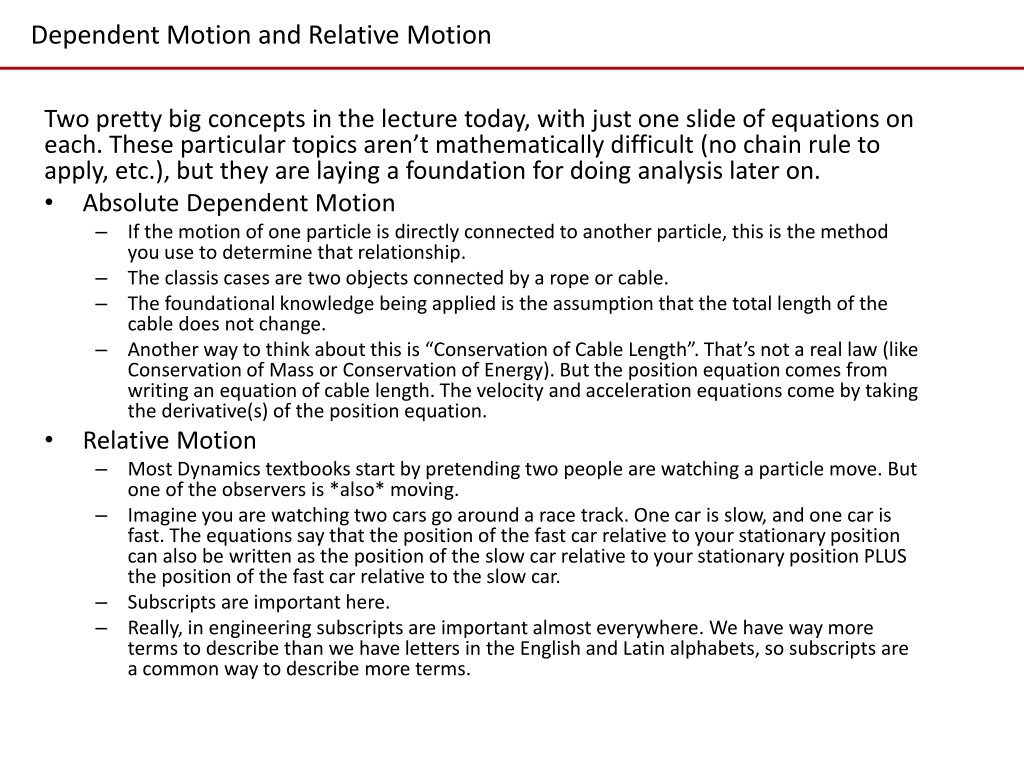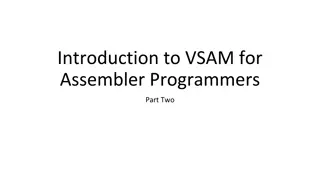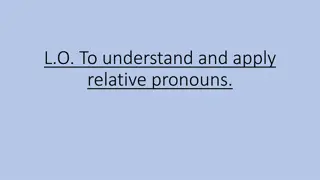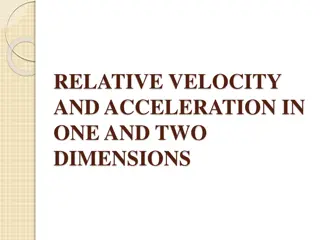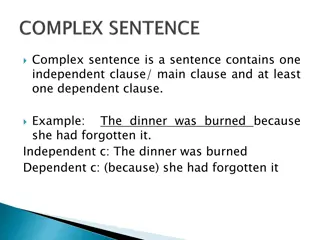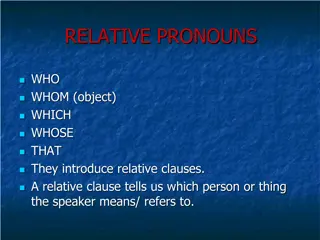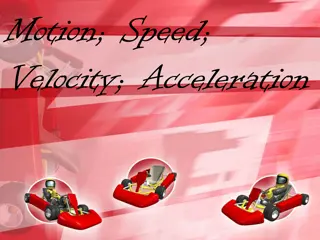Understanding Dependent and Relative Motion in Dynamics
Dependent Motion and Relative Motion are fundamental concepts in Dynamics, providing the foundation for future analysis. Dependent Motion involves constraints like ropes or cables, while Relative Motion considers observers in motion. Dynamics involves applying a limited set of equations in diverse ways, requiring a strong foundation in calculus. Despite the challenges, Dynamics teaches the application of calculus to solve real-world problems and understand system behavior.
Download Presentation

Please find below an Image/Link to download the presentation.
The content on the website is provided AS IS for your information and personal use only. It may not be sold, licensed, or shared on other websites without obtaining consent from the author. Download presentation by click this link. If you encounter any issues during the download, it is possible that the publisher has removed the file from their server.
E N D
Presentation Transcript
Dependent Motion and Relative Motion Two pretty big concepts in the lecture today, with just one slide of equations on each. These particular topics aren t mathematically difficult (no chain rule to apply, etc.), but they are laying a foundation for doing analysis later on. Absolute Dependent Motion If the motion of one particle is directly connected to another particle, this is the method you use to determine that relationship. The classis cases are two objects connected by a rope or cable. The foundational knowledge being applied is the assumption that the total length of the cable does not change. Another way to think about this is Conservation of Cable Length . That s not a real law (like Conservation of Mass or Conservation of Energy). But the position equation comes from writing an equation of cable length. The velocity and acceleration equations come by taking the derivative(s) of the position equation. Relative Motion Most Dynamics textbooks start by pretending two people are watching a particle move. But one of the observers is *also* moving. Imagine you are watching two cars go around a race track. One car is slow, and one car is fast. The equations say that the position of the fast car relative to your stationary position can also be written as the position of the slow car relative to your stationary position PLUS the position of the fast car relative to the slow car. Subscripts are important here. Really, in engineering subscripts are important almost everywhere. We have way more terms to describe than we have letters in the English and Latin alphabets, so subscripts are a common way to describe more terms.
Dynamics Big Picture Dr. Dan, I have a question. Why is Dynamics so freakin hard? -Imaginary Student Deriving Equations In most of your previous classes there are a set of equations. In Statics you had three ( Fx=0, Fy=0, M=0). In Circuits you will have Kirchholff sVoltage Law (KVL) and Kirchhoff s Current Law (KCL). In Fluid Mechanics you will use Bernouli s equation. You use these equations to derive the specific equation for the system(s) you are analyzing. In Dynamics you also have relatively few equations ? =?? ??, and ? ?? = ? ?? But then we apply those equations is a huge variety of ways. We apply them in 1, 2, and 3 directions on various coordinate systems. e.g. we apply them to particles on a spinning disk that is mounted on a bigger spinning disk. ??, ? =??
Dynamics Big Picture Dr. Dan, I have a question. Why is Dynamics so freakin hard? -Imaginary Student Dynamics is an Applied Calculus Topic In Dynamics, the governing equation for your system almost always comes from doing calculus. There are rarely any non-calculus problems (where you can look up an equation and plug in numbers). Projectile motion is one topic where the calculus has already been done for you. Position, velocity, and acceleration are all vectors. It may look like one equation, but buried inside each variable is a coordinate system, and 2-3 variables. The Dynamics textbooks assume that you can do Calc 1 and Calc 2 so well that they hardly need explanation. Those classes should teach you how to take derivatives and integrals of various functions. Dynamics should be teaching you why to take derivatives and integrals to answer questions about your system.
Dynamics Big Picture Dr. Dan, I m on the struggle bus. Does this mean I should switch to being a Rec. major? -Imaginary Student (who I have met a lot of) It Depends Being a successful Engineering Student is fundamentally different from being a successful Engineer. I want you to be both, but there are several good Engineers who weren t great Engineering Students. You have to be good enough to stay in school, and learn enough to be successful in follow-up classes. Calc I and Calc II were about material that you will probably use in 4-6 future classes (not the hard stuff) Statics will be used in 1-5 future classes Dynamics will be used in 0-2 future classes You need to offer something of value to your employer. I can solve any trig/calc problem you throw at me I can mathematically simulate anything you can imagine I know how to make things out of components/materials I can write code better than I can write sentences I understand simulating and programming control system like a second language I can motivate and manage other people to do more work than I can do myself I can talk to uneducated people about technical content in a way that they can understand I can .
12.9 Absolute Dependent Motion Analysis of Two Particles The motion of one particle depends directly on the motion of another particle. Procedure for Analysis Write an equation for the length of each string/rope/wire Parts that wrap around pulley can be ignored *if* the wrap angle doesn t change. Reference lengths from unmoving datums if possible Find relative velocity by taking time derivative of the string length equation Find relative velocity by taking time derivative of the string length equation Example 1: + + = s CD l s l A B T + = = 0 or v v v v A B B A + = = 0 or a a a a A B B A
12.9 Absolute Dependent Motion Analysis of Two Particles The motion of one particle depends directly on the motion of another particle. Procedure for Analysis Write an equation for the length of each string/rope/wire Parts that wrap around pulley can be ignored *if* the wrap angle doesn t change. Reference lengths from unmoving datums if possible Find relative velocity by taking time derivative of the string length equation Find relative velocity by taking time derivative of the string length equation Example 2: h s + + = 2B s l A + = = 2 0 or 2 v v v v B A B A + = = 2 0 or 2 a a a a B A B A
12.10 Relative-Motion of Two particles Using Translating Axes Translating frame of reference is attached to and moves with particle A. Position of B with respect to A The position of B as observed by A = + r r B A r Position: B A = + v v v Velocity: B A B A = + a a a Acceleration: B A B A
In-Class Practice Problem 1 Two non-moving datums (pick one) Track positions of: End of the cable Center of small pulley Center of bottom pulley Position vectors are from datum to item of interest (direction) Write an equation for the length of the cable. Can ignore part that wraps around pulley *if* that distance does not change. Can include the part that wraps around the pulley, but just can call it a constant (c1, c2, c3, etc.)
In-Class Practice Problem 2 Do you expect the boat to be going faster or slower than 6 ft/sec? Faster/slower by a lot? Or a little? Write an equation for the length of the rope in terms of the variables given.
In-Class Practice Problem 2 There is a lot to unpack in this step Where does each term come from after taking the derivative?
In-Class Practice Problem 2 Want to be awesome? Got some free time to kill? Solve this problem using your favorite equation solver, but do it as a function of AB. Start out with AB being 150 ft and solve it until AB is 8 ft. Plot the boat velocity as a function of length AB.
In-Class Practice Problem 3 What coordinate system to use? From fixed (x-y) viewpoint what are vA, and vB? What is vA/B? From Lagrangian viewpoint, what is aA? From fixed (x-y) viewpoint, what is aA?
In-Class Practice Problem 3 Now get magnitude and direction of aA/B Do you hate yourself? If so, solve this again when A is not parallel to B. Go ahead and solve this problem as a function of time. Let t=0 at the conditions in the picture, then track position, velocity, and acceleration of both cars in 1-second intervals for the next 20 seconds.
